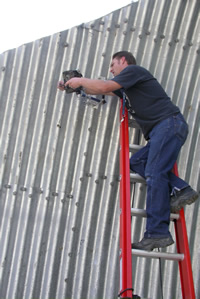Keeping Low and Staying Alive
CSUF Biologist Monitors Animals Using Harbor Boulevard
Wildlife Underpass
October 7, 2008

Paul T. Stapp
A wildlife underpass traversing Harbor Boulevard just may succeed in saving animals, but how well is still being determined in a study conducted by Paul T. Stapp, associate professor of biological science.
With $57,000 in grants from the Puente Hills Landfill Native Habitat Preservation Authority, Stapp has been monitoring whether animals are using the underpass that was constructed near Vantage Point Drive in La Habra. The underpass is located where Harbor Boulevard cuts across the Puente-Chino Hills Wildlife Corridor that stretches from the Cleveland National Forest in Orange County to Whittier Narrows.

David Elliott installs a motion-sensor camera on the side of an underpass established under Harbor Boulevard. The cameras record the passage of wildlife.
Prior to its construction, many animals trying to cross the high-volume roadway were injured or killed. Since its been built, however, some animals — recorded by motion-sensor cameras and by their tracks — have found the safer pathway.
"We were very impressed with how quickly wildlife, especially deer and coyotes, began to use the underpass. That underscores how much movement occurs through this narrow stretch of remaining open space,” said Stapp. “I'm hopeful that an additional year of monitoring will show a real decrease in road kills on Harbor as a result of the underpass."
Stapp directs monitoring of the underpass, working with graduate student Stephanie Cashin. Last year, he was assisted by David Elliott, who graduated in May with a master's degree in biology.
“We extended the monitoring by Paul Stapp for another year, until September 2009, because just as the first year of monitoring ended, we were pleased at evidence that both bobcats and small animals were also starting to use the underpass,” said Andrea Gullo, spokesperson for the Habitat Authority. Gullo said that, based on the results, changes may be made to make the underpass more effective. One possibility that might be considered, she said, is some method to direct wildlife away from the roadway and toward the underpass. As now designed, the underpass is readily accessible to the animals, but they must discover it on their own.

Motion-sensor cameras record two coyotes traversing a specially created wildlife underpass below Harbor Boulevard.

